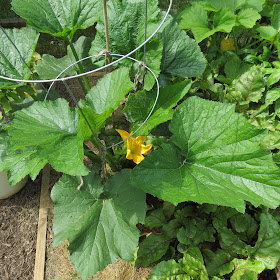Visit
The Rusted Garden's YouTube Video Channel
Follow
The Rusted Garden on Pinterest
Follow
The Rusted Garden on Twitter
Twitter will be used for Q and A, Reminders and Gardening Tips
Important: On June 20th my tomato plants
suffered some phytotoxicity which is a fancy way of saying the leaves
got burned by a chemical. I have been applying baking soda at 2
tablespoons per gallon of water since April and it has been effective.
However... that was when temperatures were really mid 80's or lower. On
June 20th the temperature was over 95 degree with a heat index of 100
degrees. I sprayed my plants the night before with baking soda. The
combination of that spray and the high heat (the next day) damaged
leaves of different plants. I am now recommending 1 tablespoon of baking
soda per gallon of water as a precaution. I will be shooting a YouTube
video to describe the damage and process.
I have been busy with the garden. I am working hard on trying to keep my spraying routines on schedule. I haven't seen any leaf spot or early blight signs. I am a bit superstitious in saying that - that I might jinx myself. I have also completed about 5 videos in the last 10 days. Several videos focus on disease prevention.
The key really, beside the odd night time dance I do in the garden to keep spores and disease away, is maintaining a spray routine.
Here are the basic of my routine that might be helpful.
I have 3 sprayers. 1 is a gallon sprayer for aspirin, baking soda and Bt. I have a 4 gallon sprayer that I haven't used yet. When the plants get larger that will become my baking soda sprayer. I have decided to go with baking soda solely for managing spores and mildews. I have used wettable sulfur in the past (it works!). I was going to do an experiment between the two but to be honest... I just don't have the time. I also have another sprayer for stronger sprays for emergencies. I haven't had to use that yet.
Oh and a 4th sprayer is a 1/2 gallon small sprayer, I fill with soapy water for aphid and early white-fly management/sighting. As soon as you see signs... soak the area with soapy water.
Aspirin Spraying:
On the 1st and 15th of each month for April, May, June, July and August... the tomatoes (definitely) and other vegetables (if I feel like it) will get 325mg aspirin/ per 1 gallon of aspirin water foliar spraying.
Baking Soda Spraying:
Baking soda spray as a way to decrease the PH on tomato leaves to make the leaf environment for spores inhospitable will occur Wednesdays and Saturdays. Baking soda will also go out on the 1st and 15th when spraying aspirin doses. This will be done through August.
Sevin Dust: (dusting not spraying)
Will be used site specific and not broadcast everywhere on my egg plant leaves 1x weekly and the bases of my zukes and squashes 1 to 2x weekly to manage flea beetles and squash bugs.
Soapy Water Spraying:
Will be used for aphids and white-flies ASAP when I notice signs. Aphids are usually managed in 1 spraying. White-flies will be target sprayed for 3 consecutive days.
Bt Spraying:
I started this in April and have sprayed about 3x a month on my kale and cabbage type leaves. I will be spraying Bt about 3-4x a month depending on rain. I also depends on how often I see the while butterfly that lays the eggs. And that has been daily for like 6 weeks! It has been EXTREMELY effective in managing the green cabbage worm/looper. My kales look great!
Foliar feeding sprays and Epson salt feedings as well as my lime slurry for calcium will occur when it look like the plants need it.
Multiple rainy days and ungodly consecutive humidity days will trigger some extra spraying of baking soda.
Good look and remember disease prevention is the key.
I have videos on my YouTube channel that detail the sprays.





































